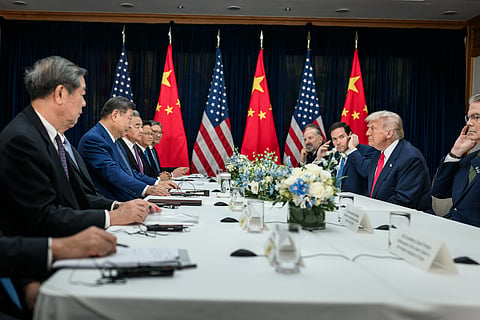

President Donald Trump emerged from his meeting with Chinese leader Xi Jinping in South Korea proclaiming an "amazing" meeting that yielded very important decisions.
The 100-minute discussion on the sidelines of Pacific Rim summits focused on trade frictions, leading to agreements to roll back certain measures and extend a truce on further escalations.
While Trump expressed optimism, Chinese officials offered measured responses, emphasizing ongoing negotiations and the need for follow-up work to achieve tangible results.
The leaders agreed to reduce U.S. tariffs on Chinese goods related to fentanyl production from 20% to 10%, bringing the average rate down to 47% from 57%.
This move, confirmed by both sides, aims to curb illicit drug flows into the United States while maintaining other tariff hikes.
China committed to purchasing 25 million metric tons of U.S. soybeans annually, starting with 12 million metric tons by January, alleviating pressures on American farmers hit by prior cutbacks.
Trump highlighted this as a "tremendous amount" of farm products, including sorghum, and urged farmers to expand operations.
On technology and resources, discussions opened pathways for Nvidia to sell computer chips to China, excluding next-generation AI models but covering a significant volume.
Beijing agreed to suspend export controls on rare earth elements for one year, removing a key roadblock for U.S. industries reliant on these minerals for electronics, vehicles, and defense.
Additional pledges included forgoing higher port fees on each other's vessels and exploring U.S. energy sales from Alaska, though details remain pending.
No resolution emerged on TikTok's ownership, with China stating it would work with Washington to address concerns.
Xi Jinping stressed the importance of dialogue over confrontation, urging negotiators to complete follow-up tasks swiftly for mutual benefits.
He referenced recent talks in Malaysia as a foundation for consensus, advocating cooperation on global issues like artificial intelligence, illegal immigration, and infectious diseases.
Analysts note Beijing's approach reflects a long-term strategy, absorbing economic pressures from tariffs while diversifying trade partners—U.S. exports now account for just 11% of China's total, down from nearly 20%.
This meeting, the first major U.S.-China summit of Trump's second term, steadies markets but underscores persistent divergences in the competitive relationship between the world's two largest economies.